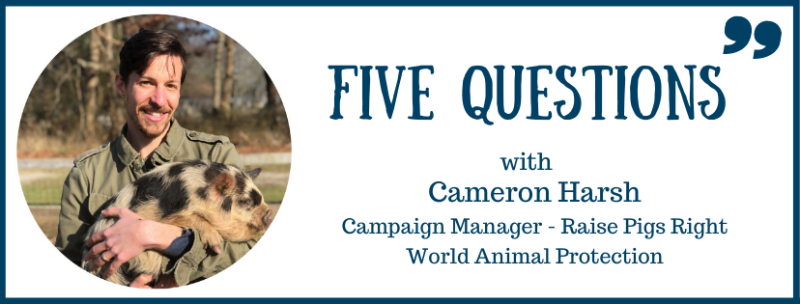5-Questions with World Animal Protection
On World Food Day (Oct. 16th), World Animal Protection (WAP) released results from a survey on global knowledge and attitudes about antibiotic use in farm animals after polling more than 15,000 people in 15 countries -- including the United States. So, this month we interviewed Cameron Harsh, farming campaign manager, from WAP to learn more about the survey and how the results can help reform of antibiotic use in farming globally.
1. Many of our readers may be new to the mission and work of World Animal Protection. Can you tell us about WAP? And can you tell us more about your work as Farming Campaign Manager?
World Animal Protection is a global non-profit with offices in 14 different countries and activities affecting change in over 50 countries. Previously known as the World Society for the Protection of Animals, we have been working since 1950 with a mission to move the world to protect animals, and focus on animals in disasters, communities, the wild, and farming. We have consultative status with the United Nations, Council of Europe, and World Organisation for Animal Health (OIE). As the Farming Campaign Manager, I work on a range of projects that aim to reduce the number of animals living in intensive confinement systems and support the growth of humane and sustainable husbandry practices. We emphasize producing robust, evidence-based reports to use in corporate engagement with major producers and retailers, public education and outreach initiatives, and policy change. World Animal Protection has also worked with other global welfare groups and experts to develop baseline, science-based, species-specific welfare standards, called the Farm Animal Responsible Minimum Standards (FARMS), and work with investors, governments, and companies to incorporate FARMS as the minimum standards across the industry.
2. You polled a lot of people! What was the motivation behind this project and what do you hope to achieve? How did you select the countries polled?
We prioritized polling in countries in which we have significant engagement or operations. We wanted to understand the extent to which citizens in these countries are aware of and concerned about the use of antimicrobials in farm animals and the connection to the spread of resistant bacteria, as well as how they perceive actions by stakeholders to address the issue.
3. We were heartened that many of the results highlighted in your report show that most people are concerned about the overuse of antibiotics in farming. What are the most significant findings from your survey? Did any findings disappoint or surprise you?
The survey showed clearly that the public is largely unaware of just how high use of antimicrobials is in the livestock industry. Eighty-two percent of respondents underestimated the percentage of antibiotics globally that go to farm animals. On average people guessed 50%, well under the actual 75% figure. This was true across nearly all of the countries, with the exception that the average estimate from respondents in Thailand was 62%. The findings also show that people globally are concerned about the direct consequences of overuse of antibiotics, with 70% indicating concern for adverse effects on their and their family’s health and 66% concerned about meat contaminated with resistant bacteria. Somewhat surprising was the overwhelming response for governments to take stronger action on the issue. Ninety-two percent believe governments should monitor and report on use of antibiotics in farm animals. Ninety percent feel governments should increase minimum welfare laws for farm animals. And, 85% believe governments should restrict use of antibiotics in farm animals. Similarly, 85% believe antibiotics should only be used on farm animals that are sick.
4. Many of our readers are based in the U.S. Did your survey show any significant differences in attitudes or beliefs in those surveyed in the US versus other countries?
There were some significant differences in results from the US compared to other countries. The US had the lowest percentage concerned about the possibility of superbugs coming from farm animals, at 79%. The next lowest was Australia at 82%. Concern was highest in Indonesia and Mexico, at 98% and 95% of people, respectively, saying they were very or quite concerned. Interestingly, US respondents were somewhat less concerned about the direct health impacts to themselves and their families from superbugs but had higher concern for superbugs entering the environment compared to many other markets, including Denmark and the Netherlands. The types of action people would be willing to take varied across countries. Sixty-four percent of US respondents indicated that they would buy meat less often to avoid superbugs, slightly above the average response across all countries, and 67% said they would avoid retailers that allow antibiotics to be used on healthy animals.
5. When it comes to global use of antibiotics in farming, what freaks you out? What gives you hope?
It is deeply concerning that the US government has not taken sufficient action to address routine use of antibiotics in farm animals. Our regulators continue to sanction uses for disease prevention across entire herds and flocks without any identified signs of disease. This failure to create clear, national policies restricting use has led to a hodge-podge of corporate commitments to limit or reduce use, many of which are very weak or promote “No Antibiotics Ever” labels. Labeling programs such as “No Antibiotics Ever” or “Raised Without Antibiotics” may at first glance seem a positive response to antibiotic overuse, but in fact have significant negative impacts on animal welfare by disincentivizing the responsible use of antibiotics when animals do get sick and need treatment. In a similar vein, we are encouraged by the European Union’s Farm-to-Fork strategy, which includes a regional ban on group disease prevention uses of antibiotics that will go into effect in 2022. Several European countries have long been leaders in reducing or eliminating routine use, and the fact that this progress is expanding across the region demonstrates that the industry can reduce antibiotics, improve animal welfare, and continue to thrive.


